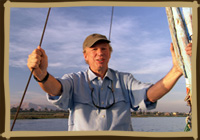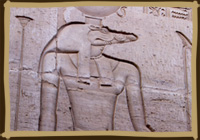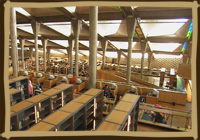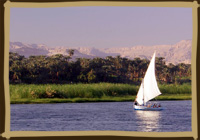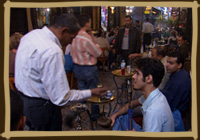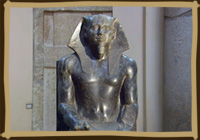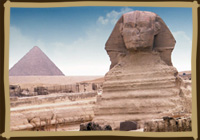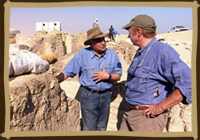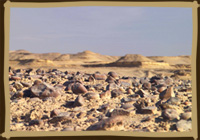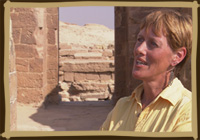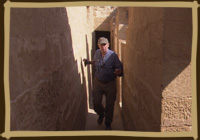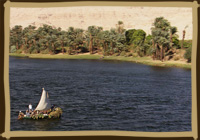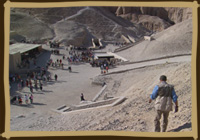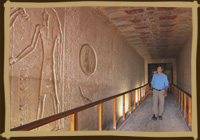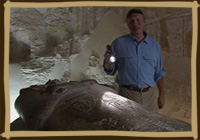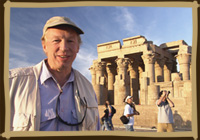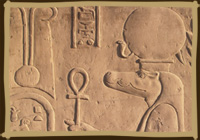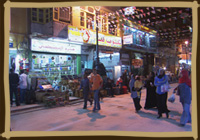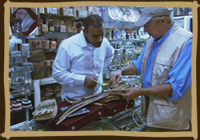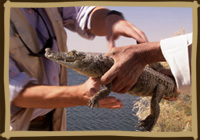
Script
Richard Voice-Over: From these waters, one of mankind’s most magnificent civilizations burst into being, and then disappeared. Here too evolved one of nature’s most magnificent animals that came to lord over all the waters. And then it vanished.
Richard On-Camera: I’m Richard Bangs. Join me on an incredible adventure as we journey up the Nile, in search of the lost crocodiles, their history, myths and culture here in timeless Egypt.
Announcer voice-over: Adventures with Purpose—they not only quicken the pulse and fire the synapses, but are also journeys of enlightenment and discovery—odysseys that make a difference. Our guide is Richard Bangs, the father of modern adventure travel. Leader of 35 first descents of rivers around the globe, a mountain climber and renowned author—Richard brings a lifetime of experience to Adventures with Purpose.
R OC: There he is – Sobek. The Lord of the Nile, this most ancient of creatures, he shaped Egyptian culture, influenced religion, even empowered the Pharaoh himself. It’s said the very waters of the Nile are the sweat of Sobek, the crocodile God.
R VO: Egypt...a vast desert...a searing sun beating down...inhospitable to man and beast. For millennia only by the grace of the waters of the Nile did people and creatures thrive in this land. Rain almost never fell. But once a year the river magically surged with water, flooding the land and leaving fertile black soil to nourish the crops. And with this annual flood, thousands of crocodiles washed into the lives of the ancient Egyptians. Death by crocodile was common, second only to death in war. The scaly beast exacted both fear and awe. The Lord of the Nile made his way into the great tombs of kings and deep into the psyche of the ancients.
As the population grew along the river, the Lord of the Nile slowly disappeared from these waters. Hunting, pollution and the Aswan dam robbed the river altogether of its ancient consort. Today there are reports that crocodiles are making a stealthy return in the south of Egypt. My goal is to catch a glimpse of this legendary creature in the wild and along the way to come to know the powerful God he inspired thousands of years ago.
This is a personal quest for me as well. In the 70’s I led an expedition to explore the upper stretches of many of the great rivers of Africa including the Nile. Of all the dangers, the crocodiles concerned me the most and so I named the expedition Sobek after the ancient Egyptian crocodile God, hoping he would look kindly upon our passage. We survived but the crocodiles of Egypt haven’t fared so well.
Our journey up the Nile tells the tale of a civilization inextricably bound to these waters and its creatures.
From Alexandria to Cairo, from the pyramids at Giza, to the Valley of the Kings, we’ll explore the way the river and its fearsome Lord molded a society. Further upstream still, we’ll visit a temple dedicated to Sobek, the crocodile God and seek the beast himself in the waters of Lake Nasser.
Our adventure begins here where the Nile melts into the Mediterranean. Alexandria. The city named for the Greek conqueror who founded it in 332 BC. The city where Cleopatra lived and reigned until Egypt fell to Rome.
Dio Chrysostom, a Greek orator, wrote in the 1st century AD, “Alexandria is situated at the crossroads of the whole world, of even the most remote nations thereof, as if it were a market serving a single city, a market which brings together into one place all manner of men, displaying them to one another, and, as far as possible, making them into a kindred people.”
That meeting of men and waters spawned a meeting of minds and ideas. Alexander the Great founded the library that would become the largest repository of human knowledge, holding at one point over half a million volumes. While the ancient library was destroyed in the Roman period, an architecturally wondrous new library has recently opened, carrying even more knowledge than before.
R OC: It was here some of the greatest advances in human though were made – from Euclid’s geometry to the determination that the earth revolves around the sun, to the discovery that it is the head, not the heart that is the seat of all human thought. And it was here in Alexandria that the Greeks encountered the reptile that they named Kroko-dilos, pebble worm, a scaly thing that lurks and shuffles amongst the stones of the Nile.
R VO: So serious were the Greeks about accumulating knowledge, that when a boat docked in the city, the library demanded the right to copy any scrolls on board. Julius Caesar helped himself to tens of thousands of books and shipped them to Rome when he occupied Alexandria in 48BC.
Knowledge didn’t just flow into Alexandria in Ptolemaic times. This city introduced the Egyptian Empire to the world. Alexandria became the gateway to the wonders of Egypt that lay upstream.
When the Egyptian fisherman plied the Nile, he did so in a felucca. This simple sailboat will spirit me back into time, back to the monuments of the ancient kingdom that flourished long before Alexandra, back to a time when crocodiles filled the river and were worshipped as Gods.
One of the beauties of the Nile is the ease of two-way travel, unique among the world’s great rivers. While the river pours downstream into the Mediterranean, boats can sail upstream on the northerly winds.
R OC: Our quest takes us south deep into the heart of earliest Egypt where we seek to unlock the mysteries of the Nile and the crocodiles who once ruled here.
R VO: The Nile cuts a tranquil path through the heart of chaotic Cairo. Feluccas, fishing boats and cruise ships sail the sighing waters here. The ancient capital of Memphis once stood on what is today the outskirts of Cairo. Founded around 3,100 BC, Memphis was the legendary city of Menes, the King who first united Upper and Lower Egypt.
Cairo sprang up later on what was then the edge of the Nile delta. Today it is one of the world’s most dynamic and fastest growing cities. The din of Cairo’s horns echoes the frustration of trying to travel through town in the stampede of stop and go traffic. And crossing a Cairo thoroughfare is the modern day equivalent of crossing the crocodile infested Nile. There are moments in modern Cairo when one can actually feel the shock of culture shock; when passing from one world to another the change is so sharp and deep as to stagger the senses. Cairo can suffuse the traveler, getting in eyes and nostrils and ears. The atmosphere is dusty, musty, and thick with scents that battle each other in the nose—the sharp-sour smoke of Turkish tobacco, the waft of diesel, and the scent of exotic perfumes. Above the sprawl is the sublime sight of the pyramids peeking through the smog.
R OC: This is the grand Cairo bazaar, where you can find almost anything, from gold to goats, from elixirs to endangered species, from talisman to the meaning of life. Here are the world’s greatest salesmen.
R VO: In the very heart of the market, El Fishawi café drips with atmosphere. In a smoky room with cracked mirrors hangs the only crocodile I find in Cairo, a huge stuffed scaly sentinel.
R OC: In the 1950s, big game hunters flocked to Egypt to hunt crocodiles, decimating the population. But today, concern for preserving the Nile is taking hold and the hunting of crocodiles is illegal.
R VO: But it may be too little, too late
To find the answer, I travel across Cairo to speak with Dr. Sharif Baha El Din, one of Egypt's most highly regarded naturalists and a reptile expert.
Dr. El Din: They disappeared about a hundred years ago from the lower part of the Nile. But they have increased in some parts, like Lake Nasser.
R: Is there an economic benefit from saving the crocodile?
Dr. El Din: Yes, certainly. If you have some interpretation of their breeding or if you have a very good site to see them, I’m sure people will spend X amount of days to go out and have this kind of adventure. So they are a good resource—a valuable resource—for tourism certainly.
R VO: While it seems there is hope for the crocodiles in southern Egypt, it’s clear they can’t return to densely populated regions like Cairo. But here I can find the ancient crocodile God, Sobek, in the most extensive collection of Egyptian artifacts in the world.
The Museum of Egyptian Antiquities is a little like Cairo itself, jammed, chaotic and overflowing with wonders. The collection includes the dazzling funerary objects found in the tomb of the boy-king Tutankhamen. While tomb robbers cleaned out the tombs of most pharaohs in Valley of the Kings, Tut’s treasures were found nearly in tact.
For the ancients, the crocodile encompassed both good and evil. Often pictured as a man with a crocodile head, he was Sobek, the crocodile God, with the power to snatch life away, and the potential to promote rebirth. Crocodiles also played a role in the Book of the Dead, a kind of handbook to life after death. On the way to heaven, the deceased passed through a series of gates guarded by crocodiles. The correct answer to a riddle could open the gate and lead the way to the afterlife.
In the Book of the Dead the Crocodile God speaks, “I am Sobek, and I seize like a ravening beast. I am the Lord to whom bowings and prostrations are made”
Egyptian religion revolved around the belief that life continued after death. To live in the afterlife, the deceased needed to keep his preserved body. Mummification became a science. Mummified animals, like crocodiles, were placed in tombs to protect the dead and bring power and fertility to the hereafter.
One of the great mysteries of Egypt is why the ancients built these giant pyramids, these grand tombs.
R OC: Well one of the reasons may be the crocodiles. During the annual floods, the Nile would tear down this valley bringing fertile soil and lots of crocodiles. Many of the Egyptians equated the presence of the crocodiles with the rebirth of the dead soil and it gave them faith that there may in fact be an afterlife; and believing that they would build these monuments and fill them with precious objects and everyday items in hope that they could carry them with them to the afterlife.
R VO: It all began here in the Old Kingdom about 2600 BC, when a visionary servant of the pharaoh Djoser had the idea to build his king’s tomb in stone. His name was Imhotep and he was the first common man to become deified. A doctor, artist, architect and sculptor, Imhotep invented the stone column nearly 2000 years before the Greeks and built the first pyramid, the step pyramid, at Sakkara, not far from Giza. The step pyramid is, in essence, a series of mastabas, the low flat tombs of the time, piled one upon another.
The next generation of pharaohs took Imhotep’s revolution further – smoothing out the sides of the pyramids. The oldest and largest of the Giza pyramids is Cheops, and it remained the tallest structure in the world until Gustave Eiffel built his tower in Paris in 1889.
The numbers stagger: nearly 500 feet tall, built from approximately 2,300,000 stones each weighing two and a half tons. And the accuracy with which they are constructed – level to within less than an inch, almost perfect right angles at the corners, with each side of the pyramid identical to within 2 inches. How ever was this possible 4,500 years ago?
In the dark chambers of the ancients’ tombs, the afterlife began, watched over by the crocodile. This is the tomb of Mereruka near the step pyramid in Sakkara. Son in law of Pharaoh Teti in the late Old Kingdom about 2300 BC, Mereruka was second in line to the throne. Scenes of everyday life, of hunting, reaping the harvest and dancing fill the walls. A crocodile under a boat battles with a hippo.
Here the fruits of the Nile are celebrated in stone. From the fragrant lotus flower to plentiful fowl to the beasts that labored in the fields. The fertile land that the Nile nourished awaits the deceased in the afterlife.
The crocodile didn’t simply adorn the walls of the tombs; he guarded the deceased on his journey.
Dr. Zahi Hawass, Secretary General of the Supreme Council of Antiquities, invited me to an active dig site at Sakkara.
Dr. Hawass: They know that crocodile can really help them to ascend to the afterworld. That is the animal….They are not afraid of him but they are putting him (here) to protect their own tombs from people. In this excavation I’ll show you now, we just announced it about three days ago. This is the excavation of the tomb of three dentists. They were the dentists of the King, dated back 4200 years ago. And this is how I’ like you to come with me and show you the crocodile in one of the tombs.
R VO: Dr. Hawass reveals a milky white doorway discovered by robbers who have since been arrested. The hieroglyph of an eye over a tusk identifies the tomb as belonging to a dentist. Looming on the bottom of the doorway a crocodile sends a biting message to intruders.
Dr. Hawass: On this tomb for this person who was chief of the dentists, you can see at the entrance to this tomb a scene of a crocodile and a snake cutting the leg off a person. That means what they want to tell us is, “If you will enter this tomb, your leg will be eaten by a crocodile.”
R VO: The crocodile Dr. Hawass conjures up next has been mummified for more than 2,000 years.
Dr. Hawass: I think this is the most beautiful mummified crocodile that you can actually see. It is mummified by linen and of course they did the same mummification process by opening it and drying it with natural….and they put the mummification material inside. And after that, they covered the whole body with linen. They were mummified because God can not die—Gods were immortal—and Sobek is one of them.
R VO: Sand preserved much of what we know about the ancient Egyptians. According to Dr. Hawass, 70% of the tombs remain buried ….a vast treasure trove of art and ideas, waiting for the light of day.
Into the desert now, we detour west – away from the Nile-- to the ancient city that worshipped a certain voracious reptile.
Inland from Cairo the ground turns brown as pottery, baked dry as straw and brushed over with a gilding of palms at the edges of irrigation schemes. About 2 hours outside of Cairo, the desert oasis called Fayoum flowers in the parched land. A natural depression that dips well below sea level, Fayoum collected water during the flood and prospered from the rich soil left behind.
This is Lake Karun, fourth largest in Egypt and about 100 feet below sea level. During Pharonic times, when the Nile would flood it would wash crocodiles into this valley.
R OC: So many that this valley literally teemed with crocodiles. And the people saw fit to build a temple to Sobek, the crocodile god and the whole are became known as Crocodopolis.
R VO: Today the Nile no longer naturally pours through here, but canals spirit the water past some 200 water wheels, still used for irrigation. Few travelers come to this agricultural outpost, but I’ve come to seek something personal, and to uncoil an ancient mystery.
The story went that once upon a time Menes, first king of all the Egyptians, was set upon by his own dogs while out hunting. In his flight he came to the Nile, where a large croc lay baking in the sun. The crocodile, rapidly sizing up the situation, offered to ferry the desperate king across the river. With great ceremony, Menes was sculled across the river to safety. Menes went on to found the city of Crocodopolis.
Crocodile worship flourished here as nowhere else. The ancients stood in awe and wondered how each year under clear skies the Nile would overflow and swarm their lake with crocodiles. They had no answers save to worship the crocodile …for its fertility, its power, and to appease the reptile when they set out across the waters to fish.
Maher Haggag, Egyptologist: They worshiped the crocodile to bring the flood back every year and not to be a harmful flood…to be enough and sufficient quantity of water—a perfect flood.
R VO: The Greek historian, Herodotus, visiting Egypt in the 5th century BC, described how the Egyptians kept crocodiles in sacred pools near temples.
Richard: Didn’t they put jewels on the crocodiles?
Maher Haggag: They put jewels only on the master crocodile—the main one. They offered some different types of jewels to it, like a bracelet on one of the arms of the crocodile; and some earrings according to the description of Herodotus.
R VO: Little remains of the once powerful center for crocodile worship. Lake Quarun has receded and of course, the crocodiles are long gone. But on a dusty hill, a lonely and evocative excavation site reveals secrets of the ancient worship of Sobek.
Kom Ushim is the collection of ruins of a small Greco Roman hamlet that flourished along the shores of Lake Quarun from the third century BC. The site was first discovered in the early 20th century – huge numbers of papyrus documents were uncovered here, detailing daily life in this agricultural settlement.
A number of houses mark the south end of the site and the ground is littered with pot shards from the thriving wine and olive oil industry.
Dominating the site is the great temple to Sobek. Willeke Wendrich is professor of Egyptian Archaeology (UCLA) excavating at Kom Osheem
Richard: Where are we?
Prof. Wendrich: We are in the very sacred spots in the temple of Petesuchos and Pnepheros. Those are two forms of the god Sobek. The names— Petesuchos means “he of Sobek,” and Pnepheros means “he with the beautiful face,” or “he with the perfect face”; and they are indications of different parts of the god Sobek.
R VO: The supplicant in ancient times would find the temple dark and flickering with light from castor oil lamps, the air redolent with burning incense, perfumes poured over the statues. One document found here contains a petition a local man made to the crocodile God. “Is it granted me to marry Tapetheus, daughter of Marres, will she certainly be none other’s wife? Show me and give me authoritative answer to this inquiry.”
Prof. Wendrich: If you see the large niche to the right of the main altar in the south temple, that length is very suspicious. Most probably, that was used to contain a bier with the crocodile mummy on it. That bier could be taken out; and you can actually see the furthest corners of the niche, there you can see little mini-niches where the legs of the bier could have gone. That bier would have been taken out of the niche and put on the altar.
R VO: While the temple bore witness to oracles and petitions to the God Sobek, like many temples of its day it was also a granary and the vaulted rooms held stockpiles from the harvest.
Prof. Wendrich: This was part of a huge effort in the early Ptolemaic periods to develop Fayoum for agriculture. The Ptolemy needed the grain from Egypt and to buy allegiances in the Eastern Mediterranean. What you see if you walk on the site are all kinds of telltale marks of that agriculture function. If you walk the main path, what you see you see little brick pillars on the left and right and stone rounded objects. They are not road markers by any means; they are press weights for making olive oil. So olive oil production was a big thing here.
R VO: As Crocodopolis faded from power, the desert reclaimed much of the oasis. The ancients called the desert “deshret,” their word for red, and they called their land around the Nile “Kemet” for the black soil left by the flood. The desert meant death, the Nile, life.
R OC: The Nile. It winds and wends through the sands of Egypt, a great green ribbon. The ancients broke the year into three seasons: flood, receding of the flood and drought. And they worshipped Sobek, the crocodile god, as the god of the flood, fertility and rebirth.
R VO: The gift of the Nile didn’t always mean a plentiful harvest. Four out of every five floods was either too high or too low and devastated the crops. Even with a perfect flood, the ancient Egyptian worked hard planting quickly while the soil was soft, irrigating the land and harvesting before the flood came again. The ancient Egyptians had the best internal communications of any ancient society. The Nile helped create a unified kingdom spanning over 1500 kilometers from north to south. The river made possible the transportation of goods and heavy stones to build monuments. The Egyptian pharaohs were seen more by the people than any other leaders in antiquity because they traveled up and down the Nile on barges.
In many places along the river today, life carries on undisturbed by the centuries. It’s uncanny, the similarity of the 4000 year old tomb carvings and scenes we pass along the Nile.
The Nile drifts peacefully into Luxor, a major tourist destination since the time of the ancient Greeks and Romans
If the pyramids of Giza are the apotheosis of the Old Kingdom, Luxor and the Valley of the Kings are the apex of the Middle and New Kingdoms.
The focus shifted from Memphis, the city near today’s Cairo, to the south near Luxor. Much had changed. After the Middle Kingdom, around 1700 BC, foreigners invaded and for the first time ruled in Egypt. North and south fell apart, chaos ruled; despondent men threw themselves to the crocodiles. It took the brilliance and valor of two brothers, Kamose and Amosis around 1550 BC to reunite Egypt and drive out the invaders. Egypt prospered once again.
R OC: On the west bank of the Nile at Luxor, the pharaohs followed the setting sun and built their eternal homes. Here in the Valley of the Kings, even the afterlife was not free from the commanding, cruel and literally breath-taking crocodile.
R VO: Death preoccupied the Egyptians from birth. The best furniture, jewelry, vases and paintings were not used in life, but saved for the tomb. In the Old Kingdom, only the elite could build tombs and prepare for the afterlife. But as the New Kingdom dawned, everyone could ponder his or her individual fate after death. Prosperity brought about this greater leveling of society.
In the New Kingdom, anyone who could afford mummification could have it.
R OC: Three levels were offered: deluxe, standard, and the bargain basement variety. The idea of the individual with a separate soul was dawning. The pharaohs no longer had a monopoly on the afterlife.
R VO: Cheat sheets to the afterlife proliferated on tomb walls. Texts like the Book of the Dead and the litany of Re gave the newly deceased a guide to pass the many tests that led to perpetual life. And the crocodile figured mightily in this final journey.
In Egyptian mythology, the supreme test was the weighing of the heart. The heart of the deceased was placed on a scale; on the other side of the scale was a feather that represented order and justice. Looming nearby was the gaping mouth of a crocodile- headed monster called Ammut.
R OC: If the scale balanced, the God of the Underworld, Osiris, would lead the deceased to the afterlife. If unbalanced, the heart would be tossed to the crocodile headed monster and devoured.
R VO: The Valley of the Kings became a city of death, a vast necropolis, with guards and tomb builders bustling about. The kings hoped the new tombs excavated in the protecting hills would thwart robbery. They also thought a ferocious crocodile at the entrance to the tomb would ward off intruders. Deep inside the God Sobek adorned the walls, a friend of the pharaoh, and protector in the afterlife.
Dr. Hawass: This god was a very important part of the life of the ancient Egyptian as a god to protect them, give them fertility; that is why they did take care of him. That—in my opinion—was the most important god, to secure the quest for immortality.
R VO: Unfortunately the temples to Sobek may not endure as long as the myths. Many of the ancient monuments are disappearing before our eyes. The dam at Aswan, which has done so much to help life in Egypt, is also wreaking ruin on these magnificent ledgers of the past. Without the floods and silt of a free flowing Nile, the salt levels along the banks have increased. The porous rock of the temples soaks in the salt, destroying the stone. Even more devastating—the humidity from the breath of millions of tourists—is also precipitating irreparable damage.
Dr. Hawass: That’s why we need to stop this mass tourism. Egypt should be very expensive. Egypt has something that no one can have: the Pyramids, the Sphinx, mummies, King Tut. Those are something no one can have. And that’s why in my opinion, you don’t really increase the number of tourists, but you increase the quality of the tourist who come to Egypt.
R VO: Setting sail back up the Nile, I wonder what this new tourism would look like and how the popular desire to see and celebrate these sites can be met without forever losing the legacies of the past? Like the crocodiles, the monuments are endangered and in need of protection.
We head upstream to the heart of Nile crocodile country at the temple of Kom Ombo. Then to the cataracts of Aswan and finally Lake Nasser, where I will seek to verify that the crocodilus niloticus is returning.
R OC: That bank over there …that bank was once lined with crocodiles, and now there are none, nada, nil on the Egyptian Nile.
R VO: Once the top predator, the crocodile kept the fish population in balance and served as the Nile custodian, cleaning up carcasses from the river.
In ancient times, the crocodiles capsized boats and grabbed men from the shores. In one surviving text, a man instructs his son to study so as to avoid menial jobs such as the washer-man who “launders at the riverbank in the vicinity of the crocodile.”
An ancient love poem describes how a man stands gazing at his beloved across the water. “The river is between our bodies/The waters are mighty at flood-time/A crocodile waits in the shallows/I enter the water and brave the waves/My heart is strong on the deep/The crocodile seems like a mouse to me/The flood as land to my feet/It is her love that gives me strength/It makes a water-spell for me;
R OC: We are entering waters most sacred to Sobek, the crocodile God. When crocodiles flourished here, they did so in fearsome numbers. About 300 B.C., when the army of Perdiccas was crossing the Nile at Memphis, the soldiers forgot to pay their proper respect to Sobek and hundreds were killed and eaten.
R VO: On the banks of the Nile, Egyptians built a temple to Sobek and the falcon headed God, Haroeris. We’ve reach the temple Kom Ombo which means “mound of gold.”
R OC: This was the main trading center for gold from south to north. During the floods, this was an island and as the boats traveled back and forth, they were very often attacked by crocodiles and so they built a temple to Sobek, the crocodile god.
R VO: The temple dates from the later days of the Egyptian empire when the Greeks ruled Egypt around the second century BC. Most of its decorations were done under the direction of Cleopatra’s father, Ptolemy XII. There is symmetry in the design, each identical side of the temple dedicated to one of the Gods.
When the Greeks, and later the Romans, came to Egypt, they were fascinated by the sacred crocodiles.
Dr. Wendrich: In the Greco-Roman period there were many pilgrimages, especially pilgrimages related to sacred animals and gods who had a relationship with sacred animals. And there was a whole priestly industry of the mummification of those animals and mummies were sold. And I think you can see this as a kind of festival—as a festive outing. So you go out to a festive place where you normally don’t live—there’s music, there’s people milling about, there’s a lot going on. So it’s a pilgrimage; it’s a holiday; it’s a party. And you could call it an early form of tourism perhaps.
R VO: The first Roman governor of Egypt wrote in 25 BC, “Our host, one of the officials …went with us to the lake, carrying a kind of cake and some roasted meat with a pitcher of wine mixed with honey. We found the crocodile lying on the edge of the lake and when the priests went up to it, some of them opened its mouth and another put in the cake, the meat and the honey mixture.”
In the shrine to Hathor, mummified crocodiles from a nearby sacred animal cemetery are now on display.
One hundred years ago a workman excavating tombs flung aside a mummified crocodile and it burst open. Papyrus papers with fragments of lost works from Homer, Sophocles and Euripides poured out of the belly of the beast.
The brilliance of the ancient imaginings of Sobek is that its current of moral energy ran both ways, just as the Nile for navigation …. Creator, destroyer; good, evil; a god, the devil …..
The Nile is at its most beguiling near the cataracts of Aswan, with blistered cliffs, folding pages of orange sand, and the billowing sails of feluccas puffing past islands. Aswan is also site of the High Dam, the vital, pumping heart of Egypt
Alongside the Nile is the Souq of Aswan, a lively marketplace of embroidered cottons, aromatic spices, filigreed jewelry, colored scarabs, and endangered animals.
Richard: Hello, do you sell crocodile? You do?
R VO: Although crocodile hunting is illegal, contraband abounds. I find this real stuffed baby crocodile hanging next to plastic ones.
Richard: This is granite and that’s a real crocodile.
R VO: And shop owners proudly display their crocodile skin goods.
Richard: So this is real crocodile leather?
Vendor: Yes.
Richard: Is it expensive?
Vendor: Actually no, it’s not very expensive but not like normal leather.
Richard: So you tell how big they are by how far apart the scales are?
Vendor: Yes
Richard: So this is a small one.
Vendor: This is a small one. This is two meter.
Richard: A two meter crocodile?
Vendor: Actually I have one more that is bigger, but somebody...
Richard: Somebody bought it?
Vendor: Somebody bought it.
Richard: So business is good for crocodiles.
Vendor: Of course, very good. To be honest, very good.
R OC: It used to be open season on crocodiles here in Egypt. But now hunting crocodiles is illegal. But that hasn’t stopped the poachers. Here in the souks and bazaars along the Nile you can find all sorts of crocodile goods, from their hides, to belts, to shoes, to purses. Even knives that are made from the claws of baby crocodiles.
Dr. El Din: So there are demands for commercialization of crocodile catching and maybe farming sometimes because after the High Dam was established, the lake established essentially a free area for crocodiles to increase without disturbance from man. People claim there are thousands, we should control them and why shouldn’t we benefit from them and so forth. But you need to do a scientific assessment of how many animals there are. And until we really know, they should be protected.
R VO: The dam at Aswan not only eliminated all the crocodiles from the Egyptian Nile and blocked fresh soil from flowing downstream; it also submerged the traditional homeland of the Nubians. As reservoir waters rose, thousands of Nubians were re-located to Aswan or Kom Ombo.
An independent kingdom in ancient times, Nubia is now absorbed into southern Egypt and Northern Sudan. Nubia’s fabled wealth, its gold, ebony, and ivory stirred the envy of its northern neighbors back in the time of the pharaohs.
Today the Nubian Villages near Aswan mine their gold from passing tourists. But I am completely unprepared for what I discover in one home I visit.
Richard: Oh, look at that. Oh my god—literally! Sobek the crocodile god. Look at that.
R OC: I’ve come 1000 kilometers up Nile River and here in this Nubian village I found crocodilus niloticus Lord of the Nile.
Richard: You know, I’ve never seen an animal move that fast. It so fast you can’t even see it.
R VO: Fisherman in Lake Nasser sometime catch these baby crocodiles in their nets, then sell them as tourist attractions. The owners claim they take good care of their charges, but given the demand in the market for stuffed, even live baby crocodiles, I fear these descendents of Sobek have very little chance. At best, they will remain captive.
Clearly crocodiles are making a re-appearance in Lake Nasser. . But to what extent? I ask some local fishermen.
Richard: So over the years has the number of crocodiles changed? More crocodiles or less crocodiles?
Translator: He said now it’s more than before?
R: More? Since the dam?
T: After building the high dam, the crocodile’s number increased now.
T: He saw once a big crocodile, 8 meters long attacked his colleague with a fishing boat like this one. And he attacked the boat and make it upside down. And then he eat his colleague’s body. And after this they only saw some pieces of his body, of his colleague’s body.
Richard: So if you wanted the world to help you as fishermen, what could people do for you?
T: They say that crocodiles are God’s creatures like any other creature God creates. The only thing they need is to stop all crocodiles more than four meters. And they are not asking anything from others, they are only asking the help from God.
R VO: We go out to have a look for these leviathans. As the numbers of crocodiles rise in Lake Nasser, so does the controversy. Fisherman and crocodiles are at odds once again.
Perhaps in the future, fishermen will become tour guides, ferrying tourists to see the crocodiles who once disturbed a livelihood.
Crocodiles typically float just below the surface of the water. In the dizzying heat, I see phantoms lurking in the waves and along the shore. And then breathtakingly, there he is! My quest is done - the great crocodilus niloticus is alive and well!
Thanks to the Nile, the sweat of Sobek, a corridor of Egypt’s vast desert bloomed and flourished. On these fertile shores, the ideas were forged that lifted its people from subsistence to the prosperity of a great civilization.
The story of the Nile crocodile is in many ways the story of ancient Egypt itself: a powerful kingdom laid waste by time and change. But as the ancients believed, life is but a cycle of death and re-birth.
As we work to preserve the ancient monuments, so too should we seek to balance the needs of man with the needs of the environment and all its creatures.
In the spirit of that effort, I return to the Nubian Village. For a fee, Ahmed allows me release one of the young crocodiles back into the Nile at Lake Nasser.
While this small symbolic act saves the life of one crocodile, the fate of Egyptian crocodiles as a whole remains a challenge. Perhaps scientific inquiry, education, and ecotourism will someday change this age old foe of men into an ally.
The symbol of fertility, the herald of the life-giving flood, a protector in the afterlife: this magnificent creature who once exacted fear and respect now needs our help and protection.
R OC: One of the great gifts of the Nile was the crocodile. And now we’re going to give a gift to the crocodile and return him to the river where he one day may be Lord of the Nile.
R VO: Okay, Ahmed, this is the moment of truth. Is this a good spot right here? OK on the count of three.
Here’s what you can do to make a difference. Don’t wear or buy goods made from endangered species. Get involved with a wildlife conservation organization. Travel to Egypt and the Nile and see for yourself. For more information and links, go to our web site: www.AdventuresWithPurpose.tv
